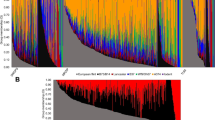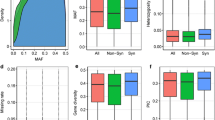Abstract
This study focuses on the standardization of techniques across laboratories to enable multiple datasets to be compared and combined in order to obtain reliable and robust wide-scale patterns of diversity. A set of protocols using a core collection of simple sequence repeat (SSR) markers, reference lines and standard alleles, plus a common system of allele nomenclature, was adopted in the study of maize genetic diversity in a network of laboratories in Asia. Pair-wise allele comparisons of the reference lines, done to assess the general agreement between datasets from four laboratories, showed error rates (raw) ranging from 5.8% to 9.7%, which were reduced to less than 8% after adjustments of correctable errors, and further reduced to less than 6% after the exclusion of all markers with greater than 10% individual error rates. Overall, 45% of the total mismatches were due to frameshift errors, 39% to wrong allele size, 15% to failed amplification and 1% to “extra” alleles. Higher genetic similarity values of the reference lines were achieved using fewer markers with data of higher quality rather than with more markers of questionable quality. Cluster analysis of the merged datasets showed the lines from southern China to be highly diverse, falling into six of the seven clusters observed and all well represented by tester lines. The lines from Indonesia fell into five of six groups, with two main groups represented by tester lines. The CIMMYT lines developed for the Asian region showed a relatively narrow genetic base, falling in two out of seven and in three out of six clusters in China and Indonesia, respectively. In contrast to the case in southern China where 95% of the lines clustered separately from the CIMMYT lines, lines in the Indonesian breeding program show a closer relationship with the CIMMYT lines, reflecting a long history of germplasm exchange.




Similar content being viewed by others
References
Bredemeijer GMM, Cooke RJ, Ganal MW, Peeters R, Isaac P, Noordijk Y, Rendell S, Jackson J, Röder MS, Wendehake K, Dijcks M, Amelaine M, Wickaert V, Bertrand L, Vosman B (2002) Construction and testing of a microsatellite database containing more than 500 tomato varieties. Theor Appl Genet 105:1019–1026
CIMMYT (1998) A complete listing of improved maize germplasm from CIMMYT. CIMMYT, Mexico, D.F.
Dubreuil P, Dufour P, Drejci E, Causse M, de Vienne D, Gallais A, Charcosset A (1996) Organization of RFLP diversity among inbred lines of maize representing the most significant heterotic groups. Crop Sci 36:790–799
George MLC, Regalado E, Warburton M, Vasal S, Hoisington D (2004) Genetic diversity of maize inbred lines in relation to downy mildew. Euphytica 135:145–155
Gerpacio R (ed) (2001) Impacts of international maize breeding research in Asia 1966–1998. CIMMYT, Mexico, D.F.
Jones CJ, Edwards KJ, Castaglione S, Winfield MO, Sala F, van de Wiel C, Bredemeijer G, Vosman B, Matthes M, Daly A, Brettschneider R, Bettini P, Buiatti M, Maestri E, Malcevschi A, Marmiroli N, Aert R, Volckaert G, Rueda J, Linacero R, Vazquez A, Karp A (1997) Reproducibility testing of RAPD, AFLP and SSR markers in plants by network of European laboratories. Mol Breed 3:381–390
Lu H, Bernardo R (2001) Molecular marker diversity among current and historical maize inbreds. Theor Appl Genet 103:613–617
Melchinger AE (1999) Genetic diversity and heterosis. In: Coors JG, Pandey S (eds) The genetics and exploitation of heterosis in crops. ASA, CSSA, and SSSA, Madison, Wis., pp 99–118
Messmer MM, Melchinger AE, Boppenmaier J, Brunklaus-Jung E, Herrmann RG (1992) Relationships among early European maize inbreds: I. Genetic diversity among flint and dent lines revealed by RFLPs. Crop Sci 32:1301–1309
Messmer MM, Melchinger AE, Herrmann RG, Boppenmaier J (1993) Relationships among early European maize inbreds: II. Comparison of pedigree and RFLP data. Crop Sci 33:944–950
Pejic I, Ajmone-Marsan P, Morgante M, Kozumplick V, Castiglioni P, Taramino G, Motto M (1998) Comparative analysis of genetic similarity among maize inbred lines detected by RFLPs, RAPDs, SSRs, and AFLPs. Theor Appl Genet 97:1248–1255
Powell W, Morgante M, Andre C, Hanafey M, Vogel J, Tingey S, Rafalski A (1996) The comparison of RFLP, RAPD, AFLP, and SSR (microsatellite) markers for germplasm analysis. Mol Breed 2:225–238
Pushpavalli SNCVL, Sudan C, Mohammadi SA, Nair SK, Prasanna BM, Gadag RN, Singh NN (2002) Analysis of simple sequence repeat (SSR) polymorphism in Indian maize inbred lines. J Genet Breed 56:229–236
Reif JC, Melchinger AE, Xia XC, Warburton ML, Hoisington DA, Vasal SK, Srinivasan G, Bohn M, Frisch M (2003) Genetic distance based on simple sequence repeats and heterosis in tropical maize populations. Crop Sci 43:1275–1282
Röder M, Wendehake K, Korzun V, Bredemeijer G, Laborie D, Bertrand L, Isaac P, Rendell S, Jackson J, Cooke R, Vosman B, Ganal M (2002) Construction and analysis of a microsatellite-based database of European wheat varieties. Theor Appl Genet 106:67–73
Rohlf FJ (1999) ntsyspc: numerical taxonomy system, ver. 2.1. Exeter, Setauket, N.Y.
Warburton ML, Xianchun X, Crossa J, Franco J, Melchinger AE, Frisch M, Bohn M, Hoisington D (2002a) Genetic characterization of CIMMYT inbred maize lines and open pollinated populations using large scale fingerprinting methods. Crop Sci 42:1832–1840
Warburton ML, Xianchun X, Ambriz S, Diaz L, Vasal S, Gonzalez F (2002b) Genetic relationships among CIMMYT maize lines developed for Asia and from other CIMMYT breeding programs. In: Proc 8th Asian Regional Maize Workshop. Bangkok, Thailand
Yap I, Nelson RJ (1996) winboot: a program for performing bootstrap analysis of binary data to determine the confidence limits of UPGMA-based dendrograms. IRRI Discussion Paper Series No. 14. International Rice Research Institute, Manila, Philippines
Yuan LX, Fu JH, Zhang SH, Liu X, Peng Z, Li XH, Warburton ML, Khairallah M (2001) Heterotic grouping of maize inbred lines using RFLP and SSR markers. Acta Agron Sin 27:149–156
Acknowledgements
This work was supported by the Asian Development Bank, Sichuan Agricultural University, the Indonesia Agency for Agricultural Research and Development, and CIMMYT. We thank M. Khairallah (formerly in CIMMYT) for her contributions in the initial part of this study, and Sutrisno (RIABGR) for the use of the institute’s facilities for the molecular work in Indonesia.
Author information
Authors and Affiliations
Corresponding author
Additional information
Communicated by J.W. Snape
Rights and permissions
About this article
Cite this article
George, M.L.C., Regalado, E., Li, W. et al. Molecular characterization of Asian maize inbred lines by multiple laboratories. Theor Appl Genet 109, 80–91 (2004). https://doi.org/10.1007/s00122-004-1626-8
Received:
Accepted:
Published:
Issue Date:
DOI: https://doi.org/10.1007/s00122-004-1626-8




